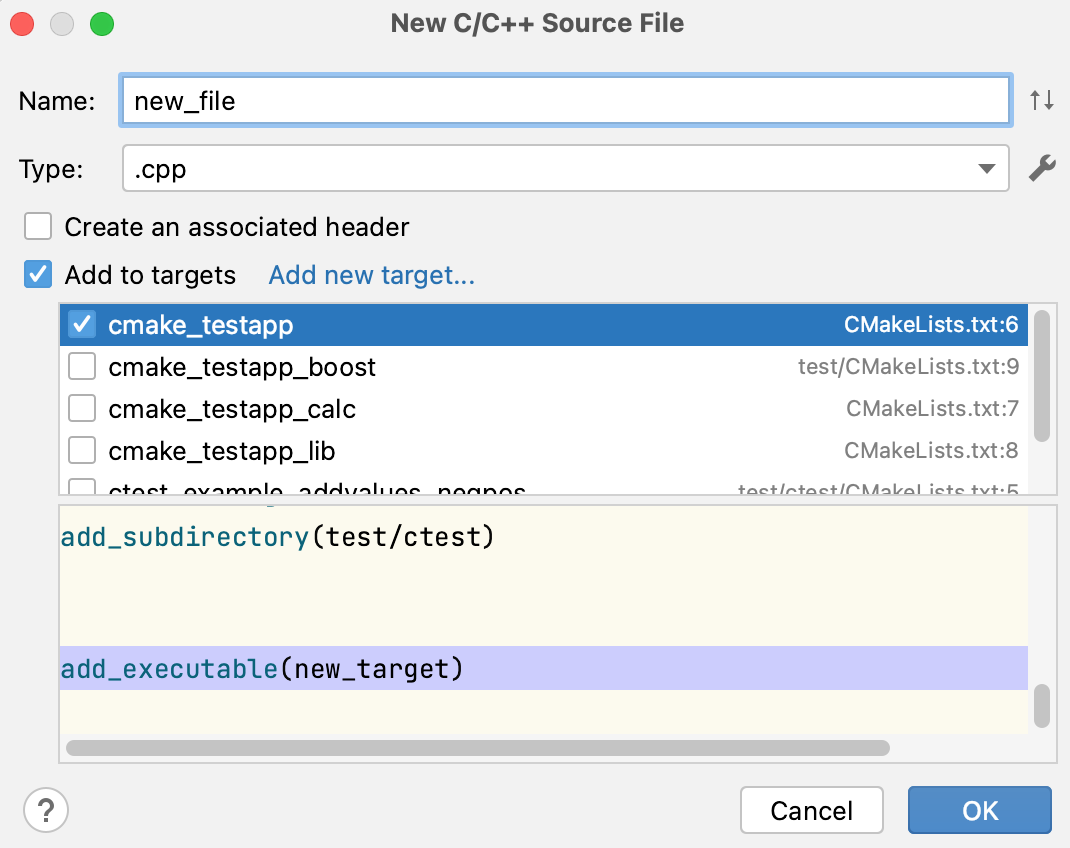
With the subdirectory files structured something like this: list(APPEND myApp_SOURCES # it doesn't have to be called CMakeLists.txt The top level CMakeLists.txt file then looks something like this: # The name of the included file could be anything, Then after all the subdirectories have been included, add_executable() or add_library() is called, but this time passing just the variable instead of an explicit list of files. The logical improvement many developers then make is to build up the list of source files in a variable as each subdirectory is pulled in via include(). It also results in having to repeat the directory structure, which reduces the benefit of structuring source files into directories in the first place. When the number of source files grows large and they get distributed over a number of subdirectories, possibly nested to multiple levels, this quickly becomes unwieldly. Eg: add_executable(myApp src1.cpp src2.cpp) Typically, developers first learn CMake in a very simple manner, defining a target by listing the source files directly in the add_executable() or add_library() command itself.

It can lead to cleaner and more concise CMakeLists.txt project files.While the CMake documentation succintly describes what target_sources() does, it fails to highlight just how useful the new command is and why it promotes better CMake projects:

With CMake 3.1, a new command target_sources() was introduced which provides the missing piece among the various target_. In such projects, traditional approaches usually either list all source files at the top-most level or build up the list of source files in a variable and pass that to add_library(), add_executable(), etc.

These files may be distributed across various subdirectories, which may themselves be nested multiple levels deep. In all but trivial CMake projects, it is common to find targets built from a large number of source files. Key updates are noted within the article. To the sub-string beginning at the right-most period.Updated December 2018: Parts of this article have been reworked to account for improvements made with the CMake 3.13.0 release. In commands thatĪccept a LAST_ONLY keyword, LAST_ONLY changes the interpretation The period) and until the end of the filename. By default, the extension isĭefined as the sub-string beginning at the left-most period (including The filename is effectively the last item-name of the path, so itĬan also be a hard link, symbolic link or a directory.Ī filename can have an extension. filenameĪ path has a filename if it does not end with a directory-separator. In other words, /usr///////lib is the same as /usr/lib. If this character is repeated, it is treated as a single directory The only recognized directory separator is a forward slash character /. The ()* characters are not part of the path. Or more item names, with multiple items separated by aĭirectory-separator. The (.)* pattern shown above is to indicate that there can be zero is aĭirectory name that refers to the parent directory. The item name consisting of two dot characters. is aĭirectory name that refers to the current directory. The item name consisting of a single dot character.

Path Structure And Terminology ¶Ī path has the following structure (all components are optional, with some The name of a variable into which the result of a command will be written. See the description ofĮach command to see how this is interpreted. With a special separator depending on the command. Ī string literal which may contain a path, path fragment, or multiple paths For commands that expect a Īs input, the variable must exist and it is expected to hold a single path. The following conventions are used in this command's documentation: Īlways the name of a variable. Synopsis ¶ Conventions Path Structure And Terminology Normalization DecompositionĬmake_path( APPEND )Ĭmake_path( APPEND_STRING )Ĭmake_path( REMOVE_FILENAME )Ĭmake_path( REPLACE_FILENAME )Ĭmake_path( REMOVE_EXTENSION )Ĭmake_path( REPLACE_EXTENSION )Ĭmake_path( NORMAL_PATH )Ĭmake_path( RELATIVE_PATH )Ĭmake_path( ABSOLUTE_PATH )Ĭmake_path( CONVERT TO_CMAKE_PATH_LIST )Ĭmake_path( CONVERT TO_NATIVE_PATH_LIST ) a drive letter when the host is not Windows), the results If the path contains elements that are not representable on the host the host platform), not the target system. The cmake_path command handles paths in the format of the build system


 0 kommentar(er)
0 kommentar(er)
